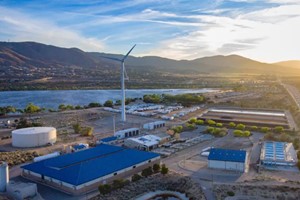Scottish Canals’ interim chief executive, Richard Millar, shares his story on what digital twin technology can do to infrastructure that has been with us for over 200 years.
The Industrial Revolution
Scotland’s canal banks played a crucial role in the creation of the Industrial Revolution. Before the advent of canals, travelling from Glasgow to Edinburgh took up to two days. However, the construction of canals enabled overnight sleeper services that increased speed and efficiency, transforming travel time to just a few hours.
This development led to the efficient transportation of massive amounts of materials, making the canal a vital component of the Industrial Revolution for over 50 years.
However, with the invention of steamboats and trains, the canal's relevance was seriously challenged, resulting in its decline. In the 1940s, the vision for Glasgow majorly involved roads, with little or no interest in canals. This led to their filling in and substitution with roads and motorways. As a result, the canal closed in the 1960s and fell into disrepair, with no one seeing its purpose anymore.
“Unfortunately, this attitude towards the canal led to it becoming a dumping ground for things that were no longer needed, the same way they saw the canal,” said Richard Millar, interim CEO of Scottish Canals, speaking at the 6th SWAN Digital Twin workshop.
The launch of the Millennium Link project
In the 1990s, volunteers and public sector workers in Scotland recognised the poor state of the country's canals and decided to take action. In 2020 they launched the Millennium Link project, a giant engineering endeavor aimed at reopening the lowland canals which had been closed since the 1960s due to a series of obstructions like motorways, pipes, and utilities.
At a cost of £3.5 million, the project removed 36 major obstructions from the waterways and had a team of 1,000 workers employed in the effort.
“With clean water and a renewed sense of purpose, people flocked to the reclaimed canals for recreation and residence purposes,” said Millar.
The project also addressed contaminated sites such as the Scottish tar works that had burned for five days in the 1970s and filled-in lock flights that connected two canals.
To further improve the canal experience and transform the canal's surrounding environments, the team designed a boatlift known as the Falkirk Wheel. The world's only rotating boat lift welcomes 700,000 visitors annually and brings new job opportunities and positive change to the area.
Nearby, in its heyday the Grangemouth canal was known as the Venice of the North and is now a petrochemical hub.
“To find a new purpose for the area, the team drew inspiration from malt whiskey, pain, and late-night thinking sessions and designed giant horses to serve as an entrance to the canal's new transformation,” added the chief executive.
Seeking A Bright Future
The Industrial Revolution and the 1960s came and went, leaving behind a loss of industry and jobs. However, the people sought a brighter future, one they could take pride in. This led to the launch of the Ferrari California T at the Kelpies, a site situated near a motorway and sewage plant, but now attracting a million visitors who come to see the art and sculpture. This transformation is a testament to the power of reinvention.
Millar said that canals lost their purpose in the 1960s when they were closed. “To remain relevant, we needed to give them a new purpose. While holiday boats and leisure boating have their place, we needed to think beyond the traditional uses and consider what they could mean in the 21st century,” he said.
By using the surface waters and deploying fiberoptic and energy cables along the towpath, the canal system has become a utility resource, delivering sustainable tourism and active travel.
“It’s hard to believe that these tow paths were once abandoned, but now they receive a staggering 30 million visits per year. The canals have not only been given a new lease on life but have become essential to Scotland's infrastructure,” he added.
Making Progress In Glasgow
In Glasgow, while the city centre is thriving, just a short distance away the north side of the city faces major health concerns with death rates and drug-related deaths far above the national average.
“We've been working hard to address these issues and help push regeneration and economic development into this area,” said Millar.
“By engaging with the community and listening to their wants and needs, we've been able to create a new arts hub in the north of Glasgow with over £120 million of investment. The transformation of the canal has been key to this progress, and digital technology has played a huge role in making it happen,” he added.
Millar said: “We now have a real canal that's 230 years old, represented in a digital twin model using software created by Autodesk.”
By using real-time and forecast data, Scottish Canals is able to monitor the canal and ensure its future success. It's clear that technology is a critical component of the ongoing work in Glasgow and will continue to be in the years to come.
The digital twin uses live sensor data and weather forecasts, to operate sluice gates to prevent flooding and extract surface water before rainfall. The technology enables hourly updates and remote monitoring, constantly learning and improving for every rainfall scenario.
This once-forgotten infrastructure now supports the construction of new homes, a health centre, and bridges for better community connections. The investment of £17 million also saved 5,000 tonnes of carbon and created jobs and activity for the people of North Glasgow.
“Above all, our project is changing lives by providing green-blue space for mental health, improving health dynamics and giving residents a sense of ownership and pride in their community. Digital technology has helped us to unlock the potential of our heritage infrastructure and create a better future for all,” concluded Millar.














